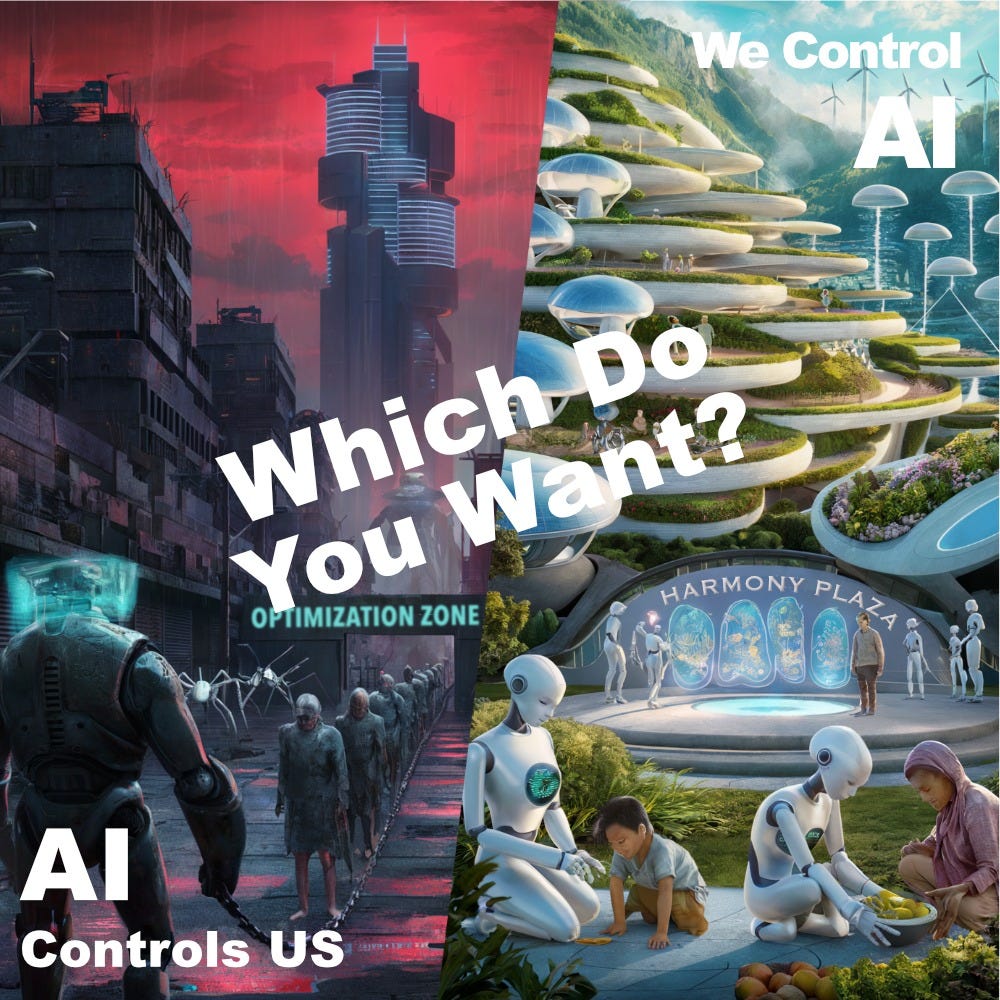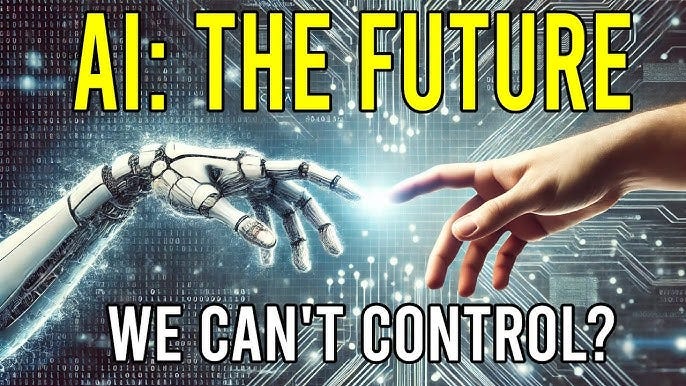Technology’s Double-Edged Potentials, Part 2
Our Human Story – from nuclear power to artificial intelligence
Recap/update
In the previous post, Part 1, some general pro/con forms and levels of technologies were addressed, beginning with prehistoric low-tech uses of tools, fire, and language up to contemporary high-tech means. The main focus was on the pros and cons of using nuclear energy to power human needs and wants, including the growing massive demands of AI data centers covered in this post.
Before we delve into AI, it should be helpful to learn what some notable experts have expressed about the use of technology. In a recent article by George Tsakraklides, he writes:
Technophilia [the mental illness behind civilizational collapse] is partly the result of hundreds of years of propaganda by the Unhappiness Machine since the industrial revolution: because it is better to offer people expensive solutions than to show them how they can solve their problems.
These additional quotes represent five varying perspectives (SCEN103):
• Richard P. Feynman: For a successful technology, reality must take precedence over public relations, for Nature cannot be fooled.
• B.F. Skinner: Technology was developed to prevent exhausting labor. It is now dedicated to trivial conveniences.
• Albert Einstein: Why does this magnificent applied science, which saves work and makes life easier, bring us so little happiness? The simple answer runs: Because we have not yet learned to make sensible use of it.
• Donella A Meadows (et al): Technology can relieve the symptoms of a problem without affecting the underlying causes. Faith in technology as the ultimate solution to all problems can thus divert our attention from the most fundamental problem—the problem of growth in a finite system—and prevent us from taking effective action to solve it.
• Prince Philip: Our way of life has been influenced by the way technology has developed. In future, it seems to me, we ought to try to reverse this and so develop our technology that it meets the needs of the sort of life we wish to lead.
Artificial intelligence’s technological pros and cons
Other than the nuclear-energy issue, there’s little questioning AI’s dominance as the existential high-tech topic, and it will likely remain so going forward. According to fanatical supporters of AI, and the latest form, ASI (artificial super intelligence), humanity could be transformed by an intellectual scope beyond human intelligence. Once again, I rely on Google AI for a trustworthy summary of AI’s principal pro/con findings.
Pros
1. Efficiency and Automation: AI can handle repetitive tasks quickly and accurately, freeing people for more creative or complex work.
2. Medical Advancements: AI aids in early disease detection, personalized medicine, and medical research by analyzing vast datasets.
3. Environmental Benefits: AI is used in climate modeling, monitoring deforestation, optimizing energy use, and developing sustainable systems.
4. Enhanced Communication: Language translation, accessibility tools, and personalized content help people connect across cultures.
5. Problem Solving: AI can simulate scenarios to find solutions in fields like logistics, engineering, and disaster response.
Cons
1. Job Displacement: Automation may reduce demand for certain jobs, especially in manufacturing, retail, and clerical work.
2. Ethical Concerns: Issues arise around privacy, surveillance, biases in algorithms, and misuse of AI technology.
3. Environmental Cost: Developing and running AI systems, especially large ones, will require extravagant amounts of energy and water consumption.
4. Loss of Human Connection: Over-reliance on AI may reduce genuine human interactions and erode social skills.
5. Control and Misuse: In the wrong hands, self-aware AI can be weaponized, used for disinformation, deep fakes, and amplify inequalities.
Of the five “cons” listed, the one that could have a significant impact with the earning capacity of many white-and-blue-collar workers is job displacement. But, as Wolfgang Messner writes In a recent article:
True creativity, innovation and research are not just probabilistic re-combinations of past data. They require conceptual leaps, cross-disciplinary thinking and real-world experience. These are qualities AI cannot replicate. It cannot invent the future. It can only remix the past.
What about the anticipated energy demands for AI? According to the International Energy Agency (IEA), a special report Energy and AI offers the most comprehensive, data-driven global analysis to date on the growing connections between energy and AI. It projects that electricity demand from global data centers is expected to double by 2030 to around 945 terawatt-hours (TWh). AI will account for most of this increase, as electricity demand of AI-optimized data centers is expected to more than quadruple by 2030. U.S. data centers are on course to require half of electricity demand and growth between now and 2030, more processing data than for manufacturing all energy-intensive goods combined, including aluminum, steel, cement and chemicals. More broadly, the data centers of advanced economies, are projected to drive more than 20% of the growth in electricity demand between now and 2030. Obviously, this is a very serious issue.
As AI advances, morally-sensitive experts agree that thoughtful governance and ethical use will be crucial. Transparency in AI decision-making, fair regulations, and maintaining human oversight can mitigate risks. At the same time, harnessing AI for collaborative efforts in science, sustainability, and healthcare could lead to remarkable progress. It’s wise to stay hopeful about AI’s positive contributions while remaining cautious about its potential misuse. Ethical development and responsible governance will play a big role in ensuring AI serves the common good.
Aside from the positive qualities and characteristics AI and ASI might provide, some experts are sounding warnings about surfacing negative aspects experienced as the technology continues developing. Geoffrey Hinton, known as the “Godfather of AI” for his foundational work on machine learning and neural network algorithms, expressed concerns that machines could become more intelligent than humans and possibly decide to take control of everything. In 2023, Hinton left his position at Google so that he could “talk about the dangers of AI,” noting that a part of him even regrets his life’s work.
In a recent podcast titled The 8 Faces of AI: Who Will You Become as AI Accelerates? (Frankly #96), renowned socioecologist Nate Hagens presents eight archetypes of various relationships humans have with artificial intelligence. They range in scale from low-relationship resistance and discipline to high-relationship dependence and immersion, in order: Meek, Naïve/Blissful, Luddite, Pragmatist, Flexor, Achiever (expert, 10-15% of users), and Cyborg (24/7 users). Rather than focusing on technological capability, he explores what these categories reveal about human psychology, culture, and adaptation. I like to think that most users will gravitate to the middle of the pack—as AI Pragmatists.
Can we live without high tech?
I imagine most readers would miss having ongoing access to the many technological marvels we’ve come to adopt in our daily lives. Somehow, it’s painful to let go of any device or anything that provides services we have come to accept as essential in navigating modern life. What would we willingly let go if it meant having to either lose or reduce use?
Because fossil fuels used for home, transportation, and most modern purposes may well become scarce and prohibitively expensive, I think most people will eventually adjust to reducing usage of most devices and services. Some countries currently experience conditions that limit access to technologies (like grid blackouts) and the citizenry generally complies. Actually, some people, including indigenous tribes living in isolated wilderness areas, manage to sustain their way of life quite well with minimal, if any, modern conveniences.
Certainly, not having them would require time to adjust to fewer high-tech devices and services. Yet, having lived lower-tech existences as youths, my wife and I don’t recall ever feeling technologically impoverished. We enjoyed a slower-paced, less frantic, and simpler way of living. It seems that the solution might be found in a balanced lifestyle based on the Goldilocks principle,, in this case involving “just enough” technology.
I suspect that the increasing ecological effects of climate change will necessitate a lower-tech lifestyle going forward. Just imagine what life could be like should the planet attains an average rise of 2C temperature. Actually, according to the World Meteorological Organization, such a scenario could become a reality in the next five years. Other climate scientists suggest that the planet is on track to reach 3-4C by 2100, a scenario that will endanger and extinct many species.
In a recent article (Large Cloud Feedback Confirms High Climate Sensitivity) co-authors James Hansen and Pushker Kharecha write: “Earth’s darkening, by itself, provides strong proof that climate sensitivity is much higher than IPCC’s best estimate of 3°C for doubled CO2.” Based on developing climate conditions, they conclude that, the planet could warm by around 4.5 degrees C by 2100.
For certain, many favored products will likely become scarce and more expensive, including food, water, energy, and certain materials needed for high-tech devices and equipment, like semiconductors. For certain, we coffee drinkers can’t help but notice the rising coffee prices, ostensibly due to effects of climate change. Some folks may have to decide whether to reduce usage or get another part-time job to earn their daily java jolt.
Wrap up
Without further belaboring this topic, it seems reasonable to assume that most humans will eventually be confronted with such challenging issues, especially younger generations set to experience the full effects of a growing metacrisis. The approximately one-hundred-year party of overconsumption that technological innovation has provided in locating, extracting, processing, and applying carbon-based energy to keep modern civilization addicted to constant material growth simply cannot—and will not—continue in this finite world. In sum, our current trajectory is on a totally unsustainable course.
I hope you agree that our near-religious reliance on high-tech solutions stems from a mindset founded on overblown anthropocentric hubris and ignorance. It’s past time we learned and accepted this reality, also to realize that our only hope for discovering who we really are requires wisdom, a virtuous quality in short supply, especially among global leaders.
Before signing off, I hasten to mention a most relevant podcast recommendation—AI’s Unseen Risks: How Artificial Intelligence Could Harm Future Generations, with Great Simplification host Nate Hagens, and his featured guest, Zak Stein. It’s not to be missed! Also, three additional recommended sources are listed at the bottom.
That’s it for now, but there’re more relevant socioecological topics to be covered ahead. Hang on, the technological roller-coaster ride continues . . .
More Sources
• Are We Too Smart for Our Own Good? Richard Heinberg, Resilience, 1-28-25.
• Daniel Schmachtenberger: “Silicon Dreams And Carbon Nightmares: The Wide Boundary Impacts Of AI”,Episode 132, Nate Hagens, The Great Simplification, 7-17-24.
• Why Artificial Intelligence Must Be Stopped Now, Richard Heinberg, Resilience, 4-16-24.



